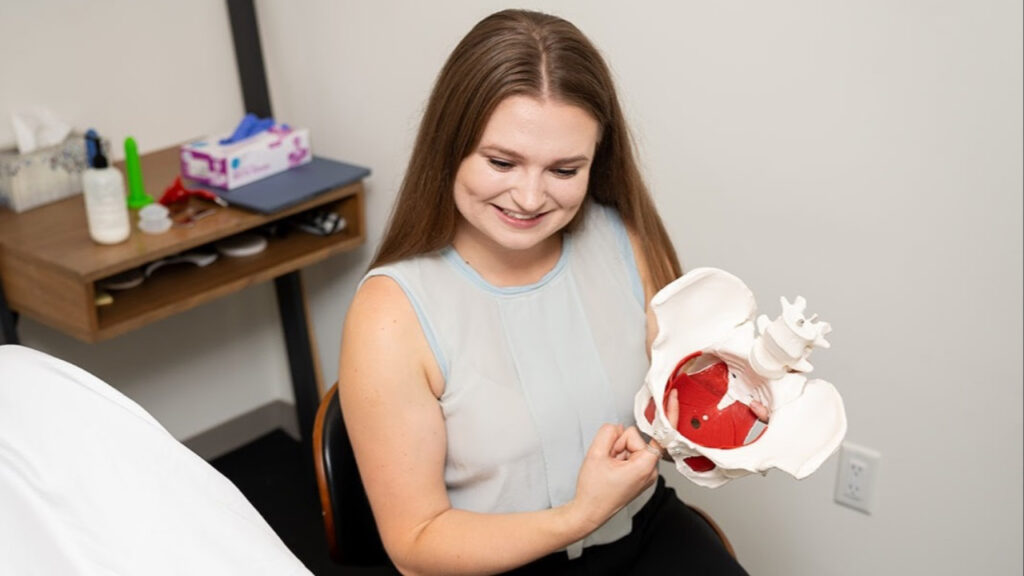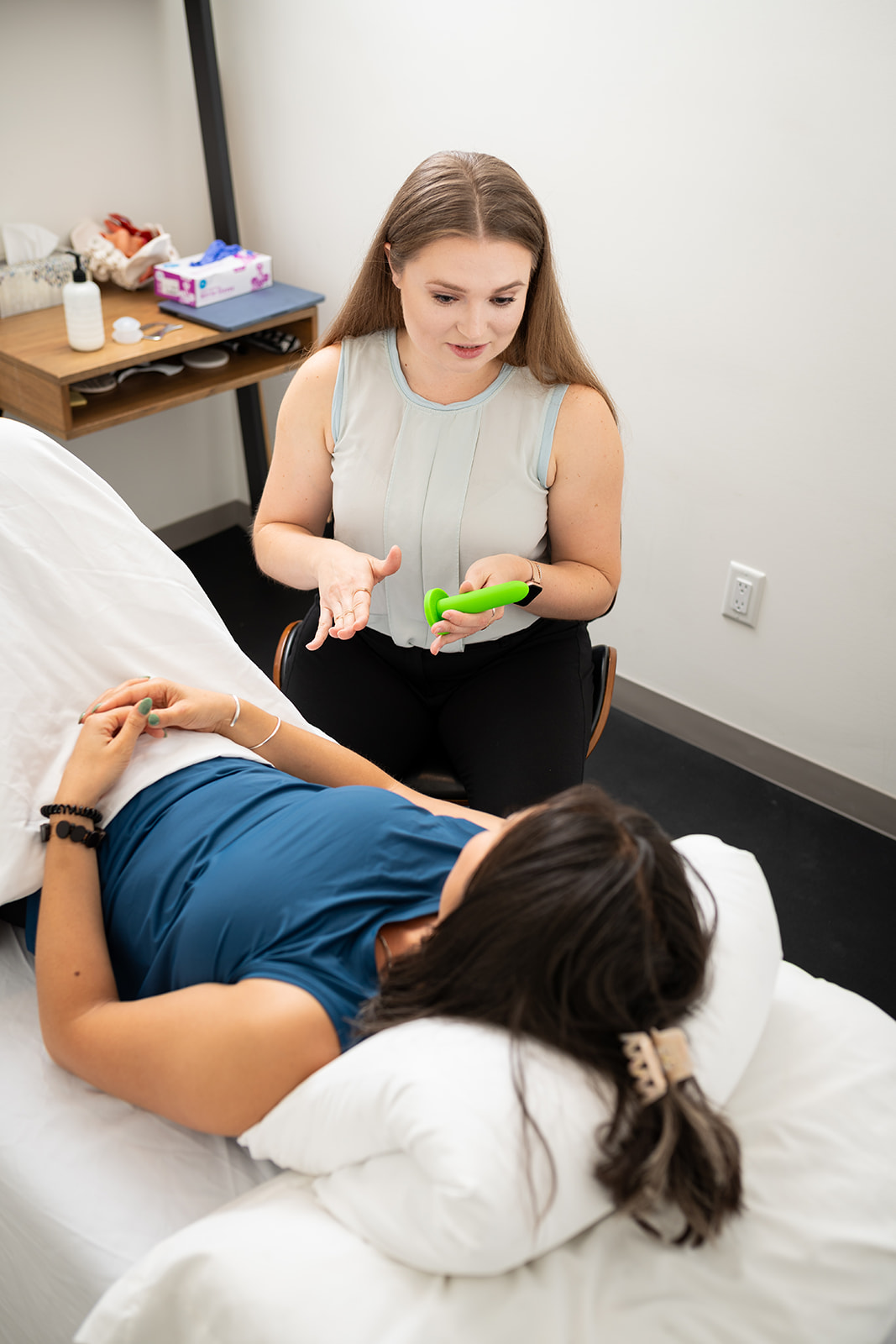Last Updated: 5/20/24
You are finally seeing a pelvic health physical therapist (yay!), and then you remember hearing about internal exams as a possibility for treatment of your concerns. If you are like most other patients, you probably have a few follow-up questions:
- What exactly is an internal pelvic floor exam?
- Is it helpful?
- How is it different from a pap smear or prostate exam?
If this sounds like you, read on!
What Is an Internal Pelvic Floor Exam?
An internal exam is a type of examination performed by trained pelvic health providers (such as physical therapists or occupational therapists) to assess the strength, length, and pain in the perineum and pelvis. This helps the provider understand if and how the pelvic floor is contributing to the patient’s symptoms.
What Specifically Happens During an Internal Exam?
Your provider will hear your story based on your intake and decide if you are appropriate for an internal exam. If you are, then they will discuss the process in detail, making sure you understand each component, have all of your questions answered, and that you consent to this type of assessment and treatment.
They will step out of the room so that you can undress from the waist down and cover yourself with the drape provided.
IMPORTANT: Consent is ongoing, and you can stop the exam at any point for whatever reason. And your provider must honor and respect that. Even if you verbally say that it is OK to proceed, if your body says no during the exam or right before the exam, then the exam or treatment is stopped. And that is 100% OK.
There are three parts to an internal exam: observation, external palpation, and internal strength assessment.
Part 1: Observation
Your provider will observe your perineum (if female, the area between your vaginal opening and anal opening) to check for the resting state of your superficial pelvic floor muscles.
Then, they will ask you to cough and then bear down to observe how your superficial pelvic floor muscles contract, relax, and lengthen, and if there is any visible organ descent.
Part 2: External Palpation for Symptoms
Your provider will use one gloved finger to gently palpate the tissues and superficial muscles around your urethral, vaginal (if applicable), and anal openings to find any areas of tenderness.
Part 3: Internal Palpation and Strength Assessment of the 3 Layers
Your provider will use one gloved lubricated finger to enter your vaginal or anal opening, assess for areas of pain, and again ask you to cough and bear down to assess your ability to contract, relax, and lengthen the pelvic floor muscles.
Because there are three layers of pelvic floor muscles going from superficial to deep, your provider can assess the strength and length of each layer of your pelvic floor muscles based on the depth of finger insertion.
If there is an area of discomfort that the patient reports or muscle tightness that the provider finds, then the provider can perform soft tissue release techniques (such as trigger point) to provide relief to the affected muscle immediately. If there is a weakness in the pelvic floor muscles, then the provider can help guide the patient in engaging and strengthening those muscles.
This can be effective in treating many conditions and be great feedback to patients especially since it is an area of our bodies that we cannot visibly see.
Indications for an Internal Exam
There are a lot of conditions for which an internal exam is recommended. Some of the typical reasons why you may need an internal exam include:
- Pregnancy
- Postpartum
- Pelvic pain
- Pelvic organ prolapse
- Urinary symptoms, such as urgency, frequency, or leaking
- Bowel symptoms, such as constipation, urgency, or leaking
However, there are some conditions that you may not even realize can be related to the pelvic floor, such as chronic low back or hip pain. You see, the fascia (connective tissue) that overlies the back and hip is close to the pelvis, so the pelvic floor can be a contributor to that pain.
If you are someone with low back or hip pain that flares up occasionally and never quite goes away, it might be worthwhile to check out your pelvic floor!
How Is This Different from a Pap Smear?
If you are a cisgender female over the age of 21, you have likely gotten or been recommended a pap smear at your primary care or gynecology appointment.
For a pap smear, the provider inserts a speculum (the tool that looks like a duck beak) into the vaginal canal and uses either a cervical brush or cotton swab to collect samples of cervical cells. The purpose of a pap smear is to screen for cervical cancer.
An internal exam with a pelvic health physical therapist does not involve a speculum or collection of cell samples. The therapist only uses one gloved finger to check for pelvic floor muscle strength, length and pain.
How Is This Different from a Prostate Exam in Males?
If you are a cisgender male over the age of 50 experiencing urinary symptoms (difficulty starting or stopping, urgency, frequency), then your primary care or urology provider may perform a manual prostate exam. It is typically done to check for an enlarged prostate and/or screen for prostate cancer.
An internal exam with a pelvic health physical therapist does not assess your prostate, since it is a gland and not a muscle. The therapist assesses the strength, length, and pain of the pelvic floor muscles, which surround the prostate.
Now You’re Ready for Your First Pelvic Health Physical Therapy Appointment
Now that you have read about what an internal exam consists of, why it can be beneficial for your physical therapy journey, and how it is different from other medical assessments, I hope you feel more confident going into your first pelvic health physical therapy appointment.
If you have any follow-up questions or are ready to meet with a pelvic health physical therapist, please reach out. I would love to hear about your story and help address your individual needs. Schedule a discovery call with me today!
You got this!
– Dr. Vera





